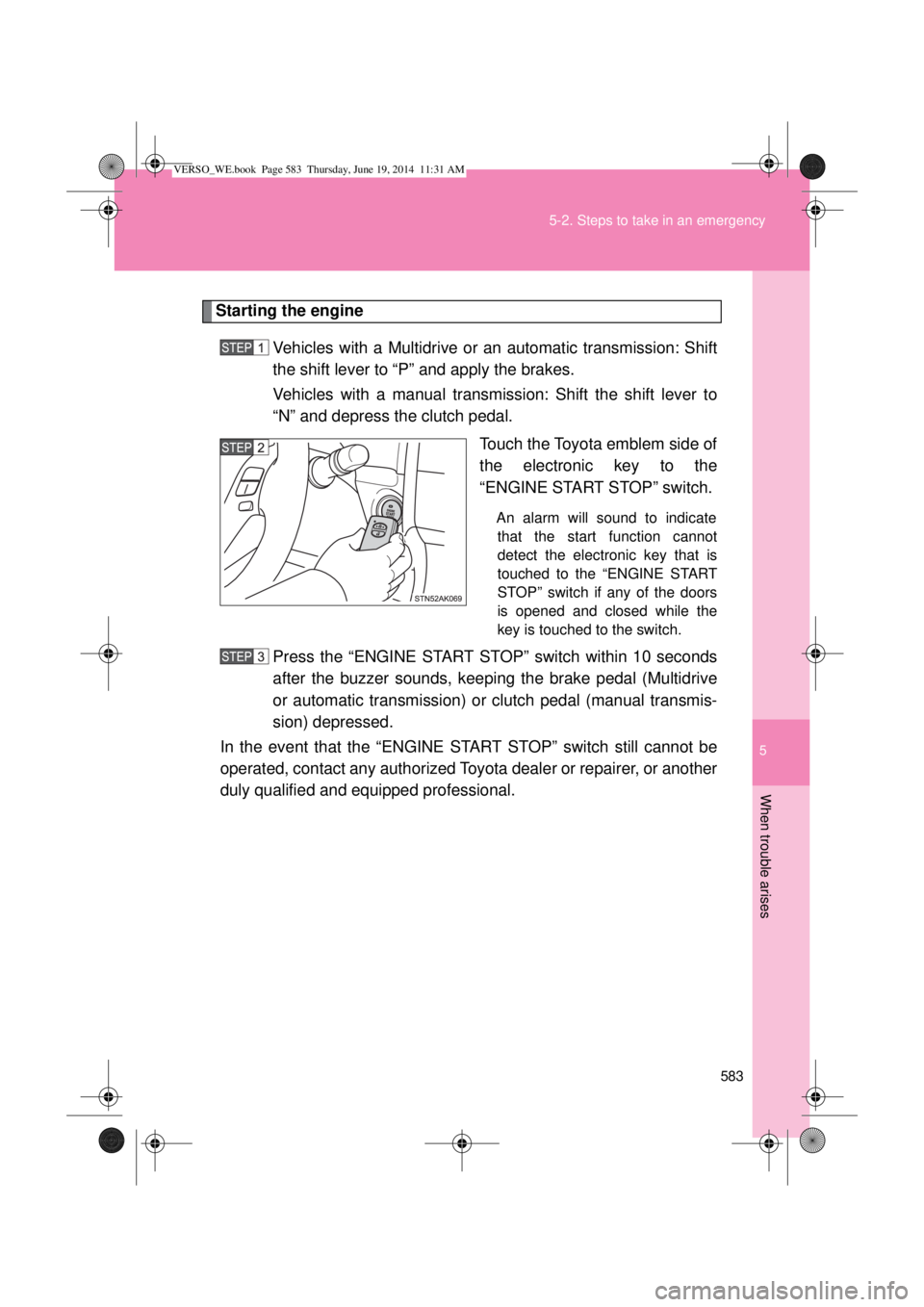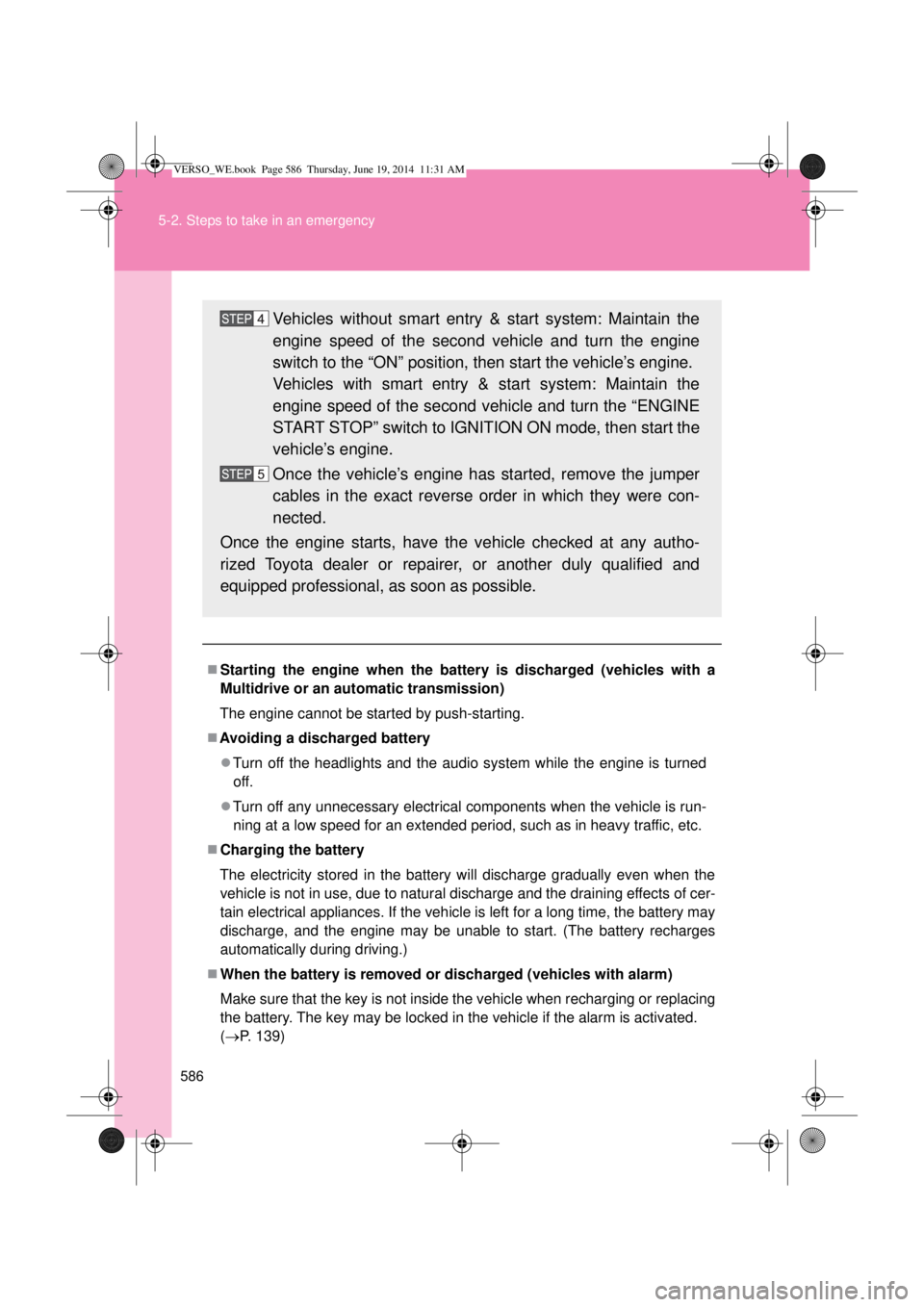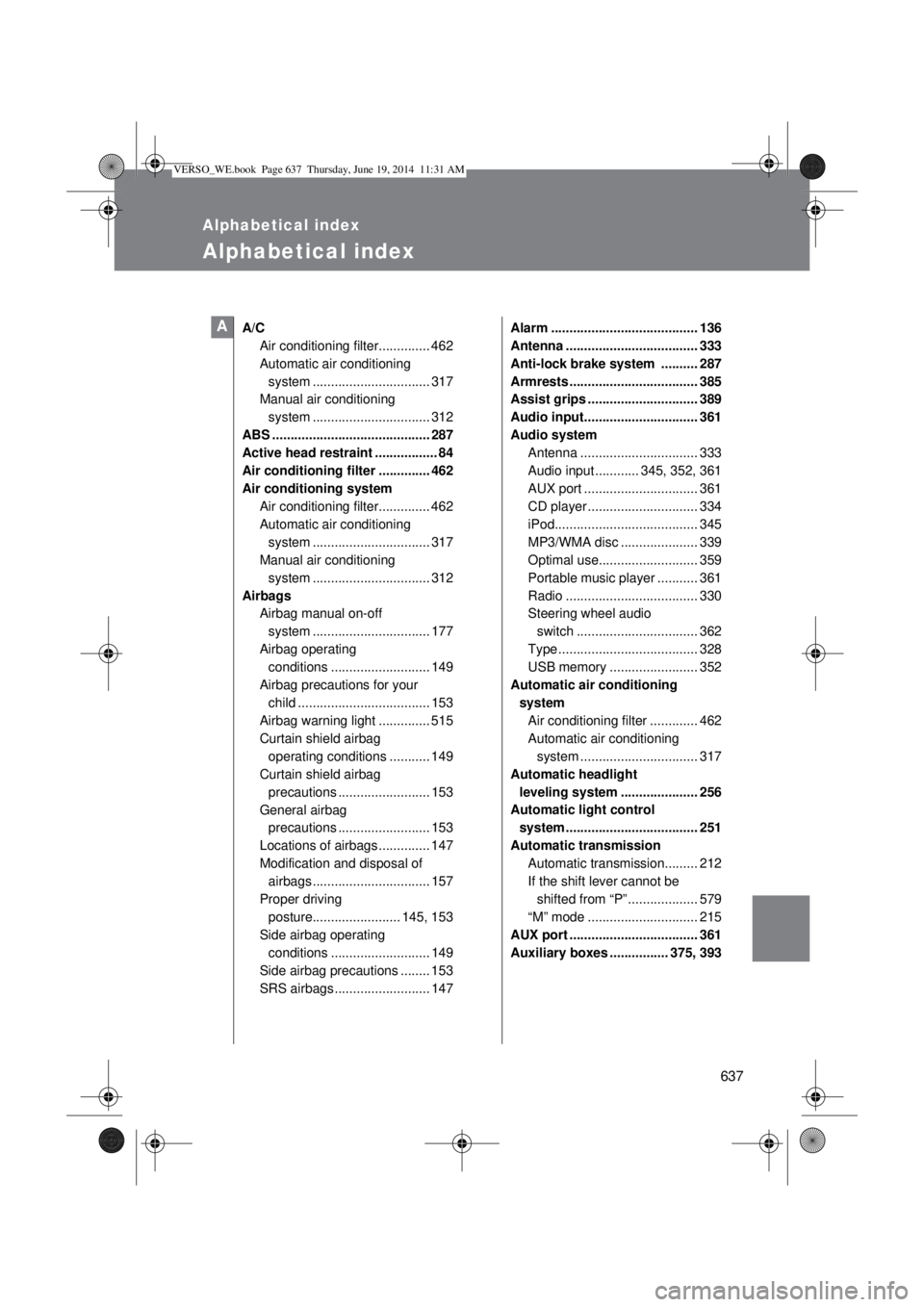Page 138 of 650

138 1-6. Theft deterrent system
Intrusion sensor (if equipped)
The intrusion sensor detects an intruder or movement in the vehicle.
The intrusion sensor can be canceled using the cancel switch.
This system is designed to deter and prevent vehicle theft but does
not guarantee absolute security against all intrusions.
Canceling the intrusion sensor
Vehicles without smart entry &
start system: Turn the engine
switch to the “LOCK” position
and press the intrusion sensor
cancel switch.
Vehicles with smart entry & start
system: Turn the “ENGINE
START STOP” switch off and
press the intrusion sensor cancel
switch.
Pressing the switch again will re-
enable the intrusion sensor.
To cancel the intrusion sensor, perform the necessary procedure
each time canceling the sensor is desired.
System maintenance
The vehicle has a maintenance-free type alarm system.
Items to check before locking the vehicle
To prevent unexpected triggering of the alarm and vehicle theft, make sure
of the following.
Nobody is in the vehicle.
The windows is closed before the alarm is set.
No valuables or other personal items are left in the vehicle.
VERSO_WE.book Page 138 Thursday, June 19, 2014 11:31 AM
Page 139 of 650
139 1-6. Theft deterrent system
1
Before driving
Triggering of the alarm
The alarm may be triggered in the following situations. (Stopping the alarm
deactivates the alarm system.)
When the battery is disconnected
Be sure to cancel the alarm system.
If the battery is discharged before canceling the alarm, the system may be
triggered when the battery is reconnected.
Alarm-operated door lock
When the alarm is operating, the doors are locked automatically to pre-
vent intruders.
Do not leave the key inside the vehicle when the alarm is operating, and
make sure the key is not inside the vehicle when recharging or replacing
the battery.The doors are unlocked using the
mechanical key.
A person inside the vehicle opens a
door or hood.
The battery is recharged or replaced
when the vehicle is locked.
VERSO_WE.book Page 139 Thursday, June 19, 2014 11:31 AM
Page 140 of 650

140 1-6. Theft deterrent system
Canceling and automatic re-enabling of the intrusion sensor
The alarm will still be set even when the intrusion sensor is canceled.
Vehicles without smart entry & start system: After the intrusion sensor is
canceled, turn the engine switch to the “ON” position or unlocking the
doors using the wireless remote control will re-enable the intrusion sen-
sor.
Vehicles with smart entry & start system: After the intrusion sensor is
canceled, pressing the “ENGINE START STOP” switch or unlocking the
doors using the smart entry & start system or wireless remote control will
re-enable the intrusion sensor.
When the alarm system is set again, the intrusion sensor will also be set.
Intrusion sensor considerations
The sensor may trigger the alarm in the following situations.
Persons or pets are in the vehicle.
Unstable items, such as dangling
accessories or clothes hanging on the
coat hooks, are in the vehicle.
The vehicle is parked in a place where
extreme vibrations or noises occur,
such as in a parking garage.
VERSO_WE.book Page 140 Thursday, June 19, 2014 11:31 AM
Page 582 of 650
582
5-2. Steps to take in an emergency
If the electronic key does not operate properly (vehicles with smar t entr y & star t system)
Locking and unlocking the doors and key linked functions
Using the mechanical key
(P. 39) in order to perform
the following operations:
Locks all doors
Unlocks all doors
Vehicles with alarm: An alarm will
sound if the alarm is set.
(P. 136)
If communication between the electronic key and vehicle is inter-
rupted (P. 63) or the electronic key cannot be used because the
battery is depleted, the smart entry & start system and wireless
remote control cannot be used. In such cases, the doors can be
opened or the engine can be started by following the procedure
below.
VERSO_WE.book Page 582 Thursday, June 19, 2014 11:31 AM
Page 583 of 650

5
583 5-2. Steps to take in an emergency
When trouble arises
Starting the engine
Vehicles with a Multidrive or an automatic transmission: Shift
the shift lever to “P” and apply the brakes.
Vehicles with a manual transmission: Shift the shift lever to
“N” and depress the clutch pedal.
Touch the Toyota emblem side of
the electronic key to the
“ENGINE START STOP” switch.
An alarm will sound to indicate
that the start function cannot
detect the electronic key that is
touched to the “ENGINE START
STOP” switch if any of the doors
is opened and closed while the
key is touched to the switch.
Press the “ENGINE START STOP” switch within 10 seconds
after the buzzer sounds, keeping the brake pedal (Multidrive
or automatic transmission) or clutch pedal (manual transmis-
sion) depressed.
In the event that the “ENGINE START STOP” switch still cannot be
operated, contact any authorized Toyota dealer or repairer, or another
duly qualified and equipped professional.
VERSO_WE.book Page 583 Thursday, June 19, 2014 11:31 AM
Page 584 of 650

584 5-2. Steps to take in an emergency
Stopping the engine
Shift the shift lever to “P” (Multidrive or automatic transmission) or “N” (man-
ual transmission) and press the “ENGINE START STOP” switch as you nor-
mally do when stopping the engine.
Replacing the key battery
As the above procedure is the temporary measure, it is recommended that
the electronic key battery be replaced immediately when the battery
depletes. (P. 465)
Alarm (if equipped)
Using the mechanical key to lock the doors will not set the alarm system.
If a door is unlocked using the mechanical key when the alarm system is set,
the alarm may be triggered. (P. 136)
Changing “ENGINE START STOP” switch modes
Multidrive or automatic transmission
Within 10 seconds of the buzzer sounding, release the brake pedal and
press the “ENGINE START STOP” switch.
The engine does not start and modes will be changed each time the
switch is pressed. (P. 202)
Manual transmission
Within 10 seconds of the buzzer sounding, release the clutch pedal and
press the “ENGINE START STOP” switch.
The engine does not start and modes will be changed each time the
switch is pressed. (P. 202)
VERSO_WE.book Page 584 Thursday, June 19, 2014 11:31 AM
Page 586 of 650

586 5-2. Steps to take in an emergency
Starting the engine when the battery is discharged (vehicles with a
Multidrive or an automatic transmission)
The engine cannot be started by push-starting.
Avoiding a discharged battery
Turn off the headlights and the audio system while the engine is turned
off.
Turn off any unnecessary electrical components when the vehicle is run-
ning at a low speed for an extended period, such as in heavy traffic, etc.
Charging the battery
The electricity stored in the battery will discharge gradually even when the
vehicle is not in use, due to natural discharge and the draining effects of cer-
tain electrical appliances. If the vehicle is left for a long time, the battery may
discharge, and the engine may be unable to start. (The battery recharges
automatically during driving.)
When the battery is removed or discharged (vehicles with alarm)
Make sure that the key is not inside the vehicle when recharging or replacing
the battery. The key may be locked in the vehicle if the alarm is activated.
(P. 139)
Vehicles without smart entry & start system: Maintain the
engine speed of the second vehicle and turn the engine
switch to the “ON” position, then start the vehicle’s engine.
Vehicles with smart entry & start system: Maintain the
engine speed of the second vehicle and turn the “ENGINE
START STOP” switch to IGNITION ON mode, then start the
vehicle’s engine.
Once the vehicle’s engine has started, remove the jumper
cables in the exact reverse order in which they were con-
nected.
Once the engine starts, have the vehicle checked at any autho-
rized Toyota dealer or repairer, or another duly qualified and
equipped professional, as soon as possible.
VERSO_WE.book Page 586 Thursday, June 19, 2014 11:31 AM
Page 637 of 650

637
Alphabetical index
Alphabetical index
A/C
Air conditioning filter.............. 462
Automatic air conditioning
system ................................ 317
Manual air conditioning
system ................................ 312
ABS ........................................... 287
Active head restraint ................. 84
Air conditioning filter .............. 462
Air conditioning system
Air conditioning filter.............. 462
Automatic air conditioning
system ................................ 317
Manual air conditioning
system ................................ 312
Airbags
Airbag manual on-off
system ................................ 177
Airbag operating
conditions ........................... 149
Airbag precautions for your
child .................................... 153
Airbag warning light .............. 515
Curtain shield airbag
operating conditions ........... 149
Curtain shield airbag
precautions ......................... 153
General airbag
precautions ......................... 153
Locations of airbags .............. 147
Modification and disposal of
airbags ................................ 157
Proper driving
posture........................ 145, 153
Side airbag operating
conditions ........................... 149
Side airbag precautions ........ 153
SRS airbags .......................... 147Alarm ........................................ 136
Antenna .................................... 333
Anti-lock brake system .......... 287
Armrests ................................... 385
Assist grips .............................. 389
Audio input............................... 361
Audio system
Antenna ................................ 333
Audio input ............ 345, 352, 361
AUX port ............................... 361
CD player .............................. 334
iPod....................................... 345
MP3/WMA disc ..................... 339
Optimal use........................... 359
Portable music player ........... 361
Radio .................................... 330
Steering wheel audio
switch ................................. 362
Type ...................................... 328
USB memory ........................ 352
Automatic air conditioning
system
Air conditioning filter ............. 462
Automatic air conditioning
system ................................ 317
Automatic headlight
leveling system ..................... 256
Automatic light control
system .................................... 251
Automatic transmission
Automatic transmission......... 212
If the shift lever cannot be
shifted from “P” ................... 579
“M” mode .............................. 215
AUX port ................................... 361
Auxiliary boxes ................ 375, 393A
VERSO_WE.book Page 637 Thursday, June 19, 2014 11:31 AM